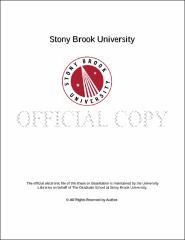| dc.identifier.uri | http://hdl.handle.net/11401/76684 | |
| dc.description.sponsorship | This work is sponsored by the Stony Brook University Graduate School in compliance with the requirements for completion of degree. | en_US |
| dc.format | Monograph | |
| dc.format.medium | Electronic Resource | en_US |
| dc.language.iso | en_US | |
| dc.publisher | The Graduate School, Stony Brook University: Stony Brook, NY. | |
| dc.type | Dissertation | |
| dcterms.abstract | WW production serves as an important test of the electroweak sector in the Standard Model. It can be sensitive to gauge boson self interactions as well as Higgs boson interactions. Deviations from the Standard Model prediction could arise from anomalous triple gauge couplings or the production of new particles that decay into electroweak bosons. Searches for new physics phenomena are conducted at high energy scales, but in order to constrain them at the electroweak scale, we need precision measurements of Standard Model processes. In this Dissertation, the WW production cross section is measured with p-p collisions at sqrt{s}=8 TeV with 20.3 fb-1 of data collected by the ATLAS detector. We only consider WW production in the fully leptonic decay channels. The experimental signature consists of two oppositely charged leptons (electrons or muons) with additional MET. The main background contributions are Z+jets, top, W+jets, and other diboson production. Data driven methods are used to estimate each background contribution except for the other diboson backgrounds, which are estimated from Monte Carlo simulations. Experimental and theoretical sources of systematic uncertainties are assessed and propagated to the final results. The measured total cross section is 71.0 +/-1.1 (stat) +3.2/-3.1 (theory) +4.8/-3.9 (exp.) +2.1/-2.0 (lumi) pb. An unfolding method is applied on differential cross section measurements to give kinematic distributions that can be compared directly to theoretical predictions. The differential leading lepton transverse momentum distribution is used to search for anomalous WWZ and WWg triple gauge couplings. The data is fitted and all coupling parameters are found to be consistent with the Standard Model values. 95% confidence level interval limits on anomalous coupling are derived and the limits are improved with respect to the previous 7 TeV WW analysis. | |
| dcterms.available | 2017-09-20T16:50:59Z | |
| dcterms.contributor | Deshpande, Abhay | en_US |
| dcterms.contributor | Hobbs, John | en_US |
| dcterms.contributor | Meade, Patrick | en_US |
| dcterms.contributor | Cochran, James. | en_US |
| dcterms.creator | Chen, Karen | |
| dcterms.dateAccepted | 2017-09-20T16:50:59Z | |
| dcterms.dateSubmitted | 2017-09-20T16:50:59Z | |
| dcterms.description | Department of Physics. | en_US |
| dcterms.extent | 155 pg. | en_US |
| dcterms.format | Monograph | |
| dcterms.format | Application/PDF | en_US |
| dcterms.identifier | http://hdl.handle.net/11401/76684 | |
| dcterms.issued | 2015-12-01 | |
| dcterms.language | en_US | |
| dcterms.provenance | Made available in DSpace on 2017-09-20T16:50:59Z (GMT). No. of bitstreams: 1
Chen_grad.sunysb_0771E_12446.pdf: 29076629 bytes, checksum: 2991fbf56405efb0f042e9e3aeb98cab (MD5)
Previous issue date: 1 | en |
| dcterms.publisher | The Graduate School, Stony Brook University: Stony Brook, NY. | |
| dcterms.subject | ATLAS, Particle Physics, Standard Model | |
| dcterms.subject | Physics | |
| dcterms.title | Measurement of the WW Production Cross Section in Proton-Proton Collisions at sqrt(s) = 8 TeV with the ATLAS Detector and Limits on Anomalous Triple Gauge Boson Couplings | |
| dcterms.type | Dissertation | |

